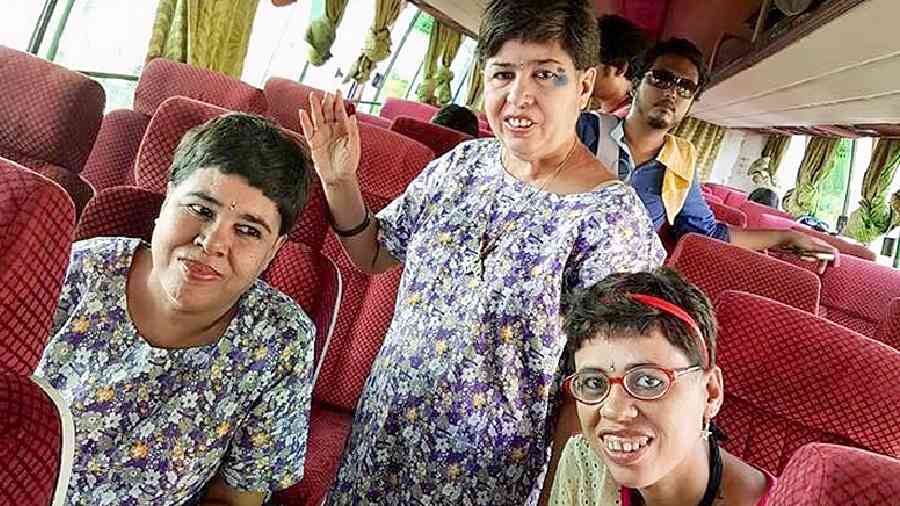In the film Three Sisters, Seema and her two sisters are going home after a long time.
Seema was brought to the Lumbini Park Mental Health Hospital in the city 10 years ago by her husband.
At her home in Bongaon, about 80km northeast of Kolkata, she had left behind her son and daughter, who were small then.
Her family did not keep in touch with her. “Whom do you miss most?” Seema is asked by Ratnaboli Ray of Anjali, a mental health rights organisation. “My children,” Seema says.
She glows as she talks about them. She misses them very much, she says. She misses her husband, too, she says, when asked about him, responding with shy laughter to the question.
What does she miss about him?
“Bhalobasa,” Seema says.
Love. But she still loves a man who has not bothered to be in touch for 10 years? Yes, she keeps smiling.
After a pause, she adds: “I had children.” Rupashi and Shikha, her sisters, want to go home too, but to their other sisters who live in the family house, not too far from Shikha’s home where she lived with her husband.
Rupashi and Shikha were admitted to the hospital 20 years ago by their father. Since then they have hardly been looked up to, but they have always yearned to go back home.
The film, shot over a day in 2017, in which the sisters are travelling in a bus with Anjali members and the film crew, is about this journey.
The sisters are both anxious and hopeful about their reception by their families. In Bongaon, the families flatly refuse to take them back, at least for the time being. It is pretty clear that they have their limitations — financial and other resources.
Seema is overwhelmed to see her son, now grown up. But her son says that if he has to look after her with his limited means, he will have to kill himself. There cannot be a greater rejection.
Yet Seema seems to understand her son’s inability, looking on at him as lovingly as before.
Rupashi and Shikha, too, when told of their sisters’ problems in accommodating them, never for once lose their dignity and grace. It is as if they knew what was waiting for them.
They just wanted to see it for themselves. One wonders how it feels to have the camera planted right there, recording everything.
Director of Three Sisters Putul Mahmood, who is also an associate professor in the department of direction and screenplay writing at the Satyajit Ray Film & Television Institute, talks about the making of the film.
She often interacts with the sisters in the film. Three Sisters, conceived by Ray, won a National Award this year. “I chose ‘cinema verite’, which is about a dynamic interaction between the filmmaking and the subjects,” she says.
In any case, she says, the filmmaking is “catalysing the event”. If that is unavoidable, the best option would be to include the process in the film creatively. In case of certain subjects, there is more reason to choose such filmmaking, says Mahmood.
“A societal silence of a deathly kind” prevails over mental illness, which helps to keep the subject “institutionalised”. The camera can disrupt this silence, taking the subject beyond the institution, in more than one way.
Mahmood prefers the word “madness” to “illness” as it opens the subject beyond pathology and “frameworks of ideas and political correctness that can be limiting from the art perspective”.
Mahmood has also directed Atasi for Anjali, which won an award at the 2020 Mumbai International Film Festival, and Two Sisters in 2007, on Rupashi and Shikha.
Taken out of the institution, the subject, with the help of a camera placed in the middle of it all, can push us beyond our imagination, helping us understand our own human situation better, says Mahmood.
The institution, in fact, emerges as the key word around the film.
Ray, who founded Anjali 20 years ago, says the film is an attempt to look at the problem of residents of mental health institutions having nowhere to go.
When the sisters are dropped back at the hospital in the evening, after their visit, they look happy, relaxed.
The institution is their “home”.
Ray talks about this relationship as problematic. “Because rehabilitation in families is such a problem, the residents stay on. The asylum becomes their safe haven. It becomes their home,” says Ray.
“The idea is that people will move out of the asylum,” she says. Hospitals become very crowded because very few leave. The family is often not a solution. “So this is a dilemma. The reality is for some people the institution will be the only home,” says Ray.
She does not think there is one solution. She imagines several kinds of spaces, including assisted living, could be a solution.
“Sometimes poverty is not the problem. I have seen the most impoverished families embracing their relatives back,” says Ray.
Respectability and class are insidious things, which can make everyday behaviour look symptomatic, says Ray. The three sisters are still at the Lumbini Park hospital.
